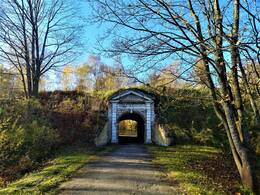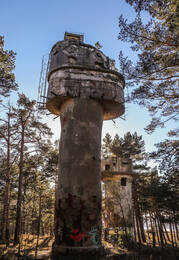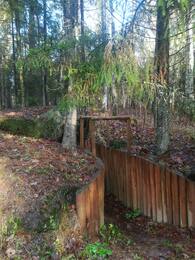Kaponieris
Capon. (prantsuse caponnière – nišš) kaitsepositsiooni ees olev tsiviilehitus, mis tagab leegi tule edasikandumise kahes vastassuunas. Kindlustustes võimaldab kapoon tulistada kogu kraavi pikkuses. Seda tüüpi kapoone on linnuste ehitamisel kasutatud alates 17. sajandist. Läti silmapaistvaim näide on Daugavpilsi kindlus.
Tänapäeva (20. sajandi) maavägede territoorium on ümbritsetud vihmaussidega, et kaitsta lahingutehnikat ja isikkoosseisu plahvatusega kaasa kantud rusude (sh tuumaplahvatuse kiirguse) eest. Gofreeritud kaponer on lisaks maskeeritud võrkude, põõsaste jms.
Rohkem teabeallikaid
Caponnière. Vikipeedia. https://fr.wikipedia.org/wiki/Caponni%C3%A8re#D%C3%A9finition
Kapten. Википедия.
https://ej.uz/uiss
https://ej.uz/gw1h
Multimeediaressurss “Dinaburgi kindlus” (fotogalerii) http://dinaburgascietoksnis.lcb.lv/arejaisizskatsLV.php
Seotud ajajoon
Seotud objektid
Daugavpilsi kindlus
Daugavpilsi kindlus asub Daugava jõe paremal kaldal linna lääneosas. See on ainus peaaegu muutumatuna säilinud 19. sajandi esimese poole kindlus Põhja-Euroopas. Ehitust alustati 1810. aastal. 1812. aastal sai kindlus kannatada sõjategevuses ja 1829. aastal üleujutuste tõttu. Daugavpilsi kindlus oli strateegilise tähtsusega koht, sh Napoleoni armee vastu võitlemisel. Kindlus pühitseti sisse 1833. aastal, aga see valmis peaaegu pool sajandit hiljem, 1878. aastal. Kindlus on jagatud kvartaliteks, mille keskosas asub paraadväljak. Hiljem kaotas kindlus oma strateegilise tähtsuse ja 1897. aastal rajati sinna ladu. Enne Esimest maailmasõda teenisid Daugavpilsi garnisonis läti sõjaväe ohvitserid, nt kindral Jānis Balodis ja kolonel Frīdrihs Briedis. 1912. aastal avati kindluse pargis mälestusmärk 1812. aasta sõja sajanda aastapäeva auks. Nõukogude ajal paiknesid siin sõjaväeüksused ja Daugavpilsi Lennunduse Tehnikakõrgkool. Praegu tegutsevad kindluses mitmed turismiatraktsioonid: Daugavpilsi kindluse kultuuri- ja teabekeskus (siit on võimalik tellida Daugavpilsi kindluse ekskursioone), Esimese maailmasõja muuseum, Daugavpilsi Mark Rothko kunstikeskuse galerii „Valge hobune”, meditsiininäitus ekspositsiooniga kontratseptsioonist, antikvariaat-salong „Housevintage“, Daugavpilsi nahkhiirte keskus ja retroautode näitus „Retrogaraž-D”.
Daugavgrīva kindlus
Daugavgrīva kindlus asub Daugavgrīva saarel Buļļupe jõe suubumiskohas Daugavasse, sinna pääseb Birzese tänavalt. Kindlus ehitati 17. sajandil kaitsmaks vaenlaste eest Riiat, olulist haldus-, kaubandus- ja tootmiskeskust. Hiljem sai sellest Läti sõjaväe rannikukaitse peamine kindlustus koos mitme tugipunktiga. Selline kaitserajatiste süsteem on Läti sõjaajaloo pärandi üks väärtuslikumaid objekte. Kindlus on Läti sõjaajaloo tunnistajaks. Näiteks Krimmi sõja ajal (1853–1856) õpetati siin välja läti ja eesti kahurilaevade meeskondi. Nende üksuste peamine eesmärk oli kaitsta kohalikke sadamaid ja rannikut Briti mereväe rünnakute eest. Esimese maailmasõja ajal moodustati siin Daugavgrīva maakaitse roodud. Need olid esimesed läti lahinguüksused, mis tegutsesid veel enne Läti kütipolke. Tänapäeval on võimalik külastada kindluse territooriumi. Lähedal asuvad Komeetfordi kindlustused ja mereäärne looduspark. Teisel pool Daugavat asuvad aga Mangaļsala kaitserajatised.
Karosta, Liepāja sõjasadam (ekskursioon)
Karosta on Baltimaade suurim ajalooline sõjaväeala, mis hõlmab peaaegu kolmandiku kogu Liepāja territooriumist. Karosta on ainulaadne sõjaväe- ja kindlustushoonete kompleks Läänemere kaldal, mis on eriline Läti ja kogu maailma ajaloos ja arhitektuuris. Karostas asuvad sellised militaarpärandi objektid nagu Põhjamuul ja -fordid, redaan, Karosta vangla, Karosta veetorn, Püha Nikolai õigeusu merekatedraal ja Oskars Kalpaksi sild.
Punaarmee ja kaponeeride punker Aizvīkai pargis
Aizvīkai mõisapark asub Gramzda vallas Aizvīkis, vaid mõne kilomeetri kaugusel Leedu piirist.
Aivvikai pargis on siiani hästi näha II maailmasõja aegsete punkrite ja kaevikute kohad. Pargis on taastatud Punaarmee punker.
Üks relvatüüpe Teise maailmasõja ajal oli "Katyusha" raketiheitesüsteem. Aizvīki pargis asus mitu sellist raketiheitmissüsteemi, isegi praegu on need kohad (caponieri) looduses selgelt nähtavad.
Aizvīkai mõisapargi kultuuri- ja ajaloopärandi põhjalikumaks tundmaõppimiseks soovitame kasutada giidi teenuseid.
Tõendid 2. maailmasõjast Aizvikai pargis
Aizvīkai mõisapark asub Gramzda vallas Aizvīkis, vaid mõne kilomeetri kaugusel Leedu piirist.
Aivvikai pargis on siiani hästi näha II maailmasõja aegsete punkrite ja kaevikute kohad. Üks relvaliikidest oli Katyusha raketiheitesüsteem. Mitmed sellised raketiheitmissüsteemid asusid Aizvīki pargis ka pärast II maailmasõja lõppu ja need kohad (caponieri) on looduses selgelt nähtavad.
See ainulaadne, saladuste ja legendidega kaetud metsapark tekkis 19. sajandi lõpus Aizvīkai mõisapargina, kui mõisaparun von Korff kattis lähedal asuva künkliku maa männi- ja kuusemetsaga. Hiljem rajati 40 ha suurusele alale jalutusrajad, istutati ka teisi puuliike ja rajati faasaniaed.
Lisaks maalilistele metsamaastikele on siin ka puidust muinasjutulised ja muinasjutulised kujundid ning kiviskulptuurid, mis jutustavad reisijatele Aizvīki ajaloo sündmustest ning tähistavad pargis olevaid kultuuri- ja ajaloolisi paiku. Parki on loodud ka Roheline klass.
Aizvīkai mõisapargi kultuuri- ja ajaloopärandi põhjalikumaks tundmaõppimiseks soovitame kasutada giidi teenuseid.








